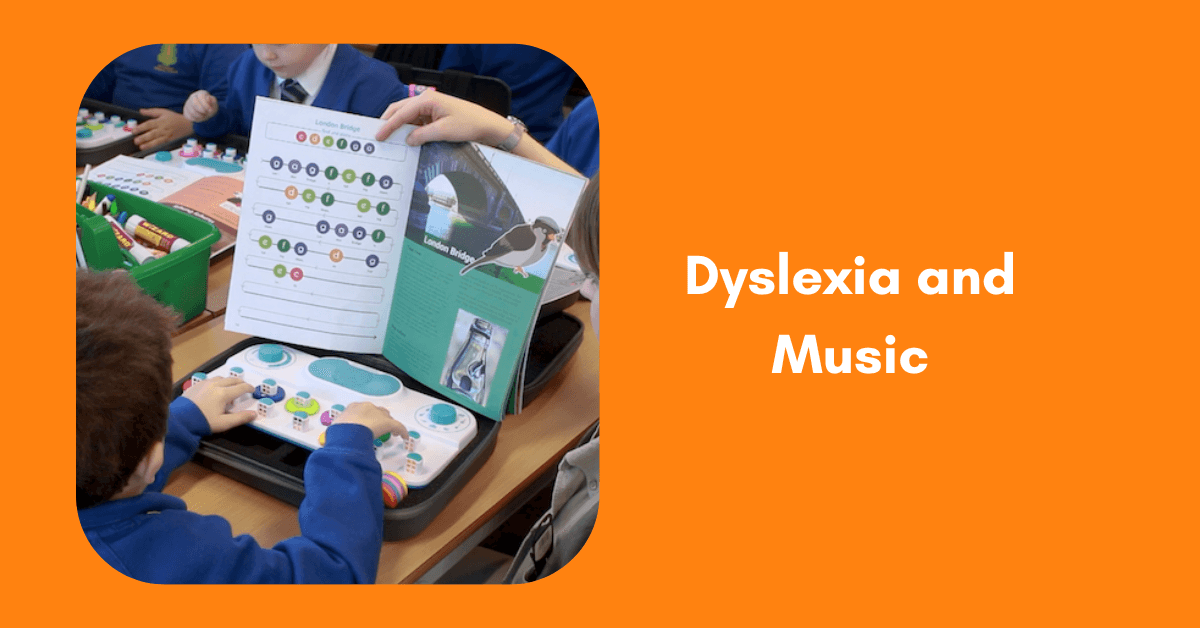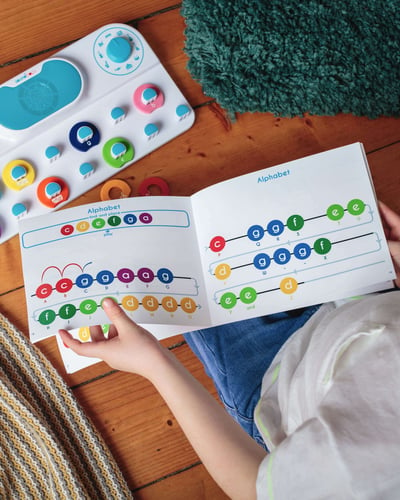
Dyslexia isn’t a condition – it’s an average. It is measured from the distribution of reading skills: if you fall below the average, then you are labelled dyslexic.
It’s estimated that 1 in every 10 people are affected.
It’s nothing to do with intelligence. It’s nothing to do with mixing up the order of letters. It’s a specific difficulty in associating symbols with sounds – the representation of speech sounds by letters – that causes problems with reading and writing.
So what are the links between dyslexia and music? Can music help children with dyslexia in other areas of learning like reading comprehension?
Let's take a closer to understand this condition and the relationship between dyslexia and music.
Dyslexia and music in young children
Preschool children begin to understand that words are made up of syllables and sounds. As children are introduced to reading, they learn to associate individual speech sounds – phonemes – with letters. Some children have difficulty distinguishing these sounds – after all, they come at a rate of ten a second or more. This is the basis of dyslexia. Music can help children distinguish between sounds and help with learning how to read.
What we know is that dyslexia is a drop of difficulty in an ocean of strengths.
People with dyslexia often have good skills in other areas, particularly creative thinking and problem-solving. We don’t know if these skills are innate or a result of having to find unexpected solutions to reading challenges, but we do know that dyslexic people have well above-average creativity and lateral thinking skills.
Many, many people with dyslexia, even those who initially struggle with reading and writing in school, go on to further education and work in jobs they love. Many of the most creative musicians and artists are dyslexic.
What are the signs of dyslexia?
The common signs of dyslexia usually become apparent when a child starts school and begins to focus more on learning how to read and write. The British Dyslexia Association have an excellent website that describes the signs of dyslexia in the early years and at primary school age. If you are worried about your child's speech and language development, you should speak to your GP or health visitor.
Some signs of dyslexia in early years and preschool children include:
- Difficulty in reciting the alphabet
- Lack of attention
- Forgetting the names of teachers and other pupils
- Family history of dyslexia
- Difficulty singing and learning nursery rhymes
As children get older, other signs of dyslexia include:
- Unusual pronunciation of words
- Trouble with timekeeping
- Difficulty following instructions
- Excessive tiredness due to concentration
There are many other signs, but be sure to raise any concerns with your child's teacher and their school.
How can music help with dyslexia?
Both speech and music involve rapid manipulations and identification of sound qualities like pitch, rhythm, and duration. Musically trained adults appear to have superior abilities in auditory perception compared to non-musical adults. It’s believed that musical training may give children with dyslexia a boost in the auditory perception skills needed to learn to read.

How should music teaching be tailored for dyslexia?
1. Pick the instrument that suits your child and their learning style. Beginning with an instrument designed for young children is a good starting point. This can lay the foundations for a traditional instrument – but which one? Is your child a strings player, a keyboardist or a percussionist? The Right Instrument for Your Child by Atarah Ben-Tovim and Douglas Boyd is very useful here.
2. Use all the senses. Lessons that involve hearing, vision and movement are more memorable and enjoyable. Use pictures, listening, demonstration, hands-on exploration and activity. Music is excellent for multi-sensory approaches because it is so interactive.
3. Use colour. It is far easier to follow and remember colour-coded notes than black-and-white notation. Once memorised, the process of learning to read music can progress level by level.
4. Use alternatives to ‘traditional’ music notation to see the relationship between symbol and sound. Improvisation and playing by ear can be rewarding and are often used by musicians.
5. Keep instructions short, clear and simple. Structure lessons. Begin and end with a summary of the lesson. In between, repeat key points.
Famous musicians with dyslexia
Many famous musicians have been dyslexic, including:
- Tony Bennett
- Cher
- Mick Fleetwood
- Noel Gallagher
- Jewel
- Nigel Kennedy
- John Lennon
- Ozzy Osborne
- Lou Reed
- Carly Simon
- Gwen Stefani
- Florence Welch




There is a close relationship between creative thinkers and dyslexia. And music can inspire young children who may feel they are struggling in school and provide an outlet. Who knows: they could be another in a long list of musicians with dyslexia.
- Music and reading comprehension are closely connected. Find out how learning to play an instrument can help with reading.
- Music is not only a powerful tool for children learning to read: it can help with their sums too! Find out how music can help with maths in this article.
- For young children starting out in music, Soundbops is the way to start music smarter. Want to know more? Find out all about Soundbops.
Adam is the Content Manager at pBone Music. This should mean that he’s the ideal person to write about himself, but he finds boasting in the third person a little awkward. He honed his word wizardry with a degree in English Language and Literature at the University of Leeds. He has since written copy for clients and businesses across the land, from awards to something beginning with “z”. He also spent a number of years as a musician. He has written pop songs and even jingles for kids, performed more first dances at weddings than you could shake a pBuzz at, and once played a gig for a pie company at The Etihad Stadium in Manchester. When he’s not reminiscing about those good old days, you might find Adam enjoying the football (although as an Everton fan, that can be difficult). He also loves spending time with his partner, Jen, and his family and friends, and sincerely hopes they feel the same way.
